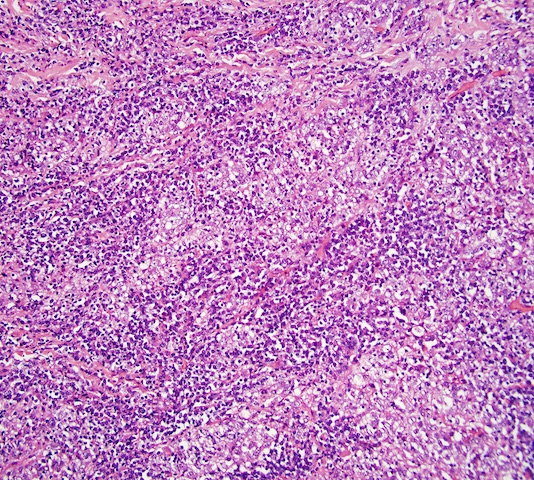Table of Contents
Definition / general | Epidemiology | Sites | Pathophysiology | Etiology | Clinical features | Case reports | Treatment | Clinical images | Microscopic (histologic) description | Microscopic (histologic) images | Positive stains | Negative stains | Differential diagnosis | Additional referencesCite this page: Tranesh G. Lymphoepithelioma-like carcinoma. PathologyOutlines.com website. https://www.pathologyoutlines.com/topic/skintumornonmelanocyticLEL.html. Accessed April 2nd, 2025.
Definition / general
- Exceptionally rare and poorly differentiated cutaneous carcinoma with prominent reactive inflammatory infiltrate
- Mimics undifferentiated nasopharyngeal carcinoma (Rare Tumors 2013;5:e47)
- WHO defines these tumors (in nasopharynx/sinonasal cavity) as lymphoepithelial carcinoma
- Importantly, cutaneous LELC is NOT associated with Epstein Barr virus (EBV) infection
Epidemiology
- Older to elderly adult patients (Dermatol Online J 2008;14:12)
- Approximately equal incidence of females and males
Sites
- Head and neck most common site
Pathophysiology
- In skin, no apparent relationship with EBV (Dermatol Online J 2008;14:12, Am J Dermatopathol 1996;18:478)
- This is in contrast to consistent EBV association with similar tumors from lung, salivary glands, stomach, thymus, nasopharynx and sinonasal cavity
Etiology
- Uncertain origin (Dermatol Online J 2008;14:12)
- Unclear whether a poorly / undifferentiated squamous cell carcinoma versus poorly differentiated adnexal neoplasm
Clinical features
- Usually firm, variably colored, face or neck plaque, papule or nodule (Dermatol Online J 2008;14:12)
Case reports
- 73 year old woman with vulvar tumor (Diagn Pathol 2011 Jan 10;6:4)
- 85 and 87 year old men (Dermatol Online J 2012;18:7, Rare Tumors 2013;5:e47)
- 89 year old woman (Dermatol Online J 2008;14:12)
Treatment
- Wide local excision or Moh's microsurgery to ensure complete removal
- Radiation reserved for recurrence or lymph node involvement (Case Rep Oncol Med 2012;2012:241816)
- Generally low recurrence and metastatic potential with complete excision (in contrast to nasopharyngeal counterpart)
- Rare lymph node metastasis (Am J Dermatopathol 2006;28:211) or death from disease
Microscopic (histologic) description
- With Diagnostic criteria:
- Well circumscribed lobules, nests or small aggregates of large, cohesive, epithelioid cells closely associated with a dense, mixed T and B lymphocytic and plasmacytic infiltrate (Rare Tumors 2013;5:e47)
- Biphasic nature may be more apparent at high magnification
- The epithelioid component generally lacks connection with the epidermis
- Cells are often polygonal and display poorly defined eosinophilic cytoplasm, vesicular nuclei with prominent nucleoli and increased mitotic activity, including atypical mitotic figures (Dermatol Online J 2008;14:12)
- Focal ductular differentiation or trichilemmal keratinization rarely reported (J Cutan Pathol 1991;18:93)
- Mandatory dense inflammatory infiltrate (polymorphous and polytypic) surrounding and intermingling with epithelial tumor cells
- Lymphoid infiltrate may obscure the epithelial component
- When inflammation predominates, may mimic lymphoproliferative disorder
- Well circumscribed lobules, nests or small aggregates of large, cohesive, epithelioid cells closely associated with a dense, mixed T and B lymphocytic and plasmacytic infiltrate (Rare Tumors 2013;5:e47)
Microscopic (histologic) images
Contributed by Sara Shalin, M.D., Ph.D.
Images hosted on other servers:
Positive stains
Negative stains
- Melanoma markers: S100 and HMB45
- Neuroendocrine markers: chromogranin, synaptophysin and CD56
- EBER (EBV encoded RNA in situ hybridization)
Differential diagnosis
- Cutaneous lymphadenoma
- Lymphoma
- Melanoma
- Merkel cell carcinoma
- Metastatic disease from nasopharyngeal carcinoma
- Poorly differentiated inflamed carcinoma
Additional references
























